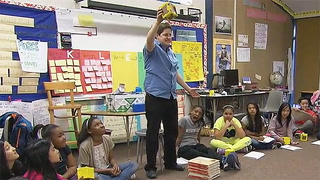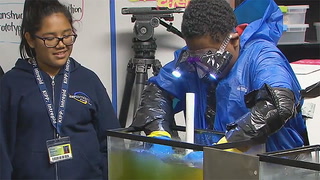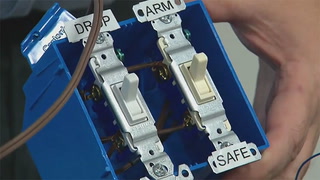GFX:
Tch
Teaching Channel
+++ 00:00:04 +++
Teacher: Wind is on.
Student: Eighty-two.
Student: We're gonna place sponges on the bottom, so when it drops, it like jumps.
Card:
Engineering Design
in the Classroom:
Egg Engineering,
Using Models & Blueprints
Destiny Woodbury: Good morning, team and family.
Students: Good morning, Mrs. Woodbury!
Destiny Woodbury: Please take out your Clues Chart from your folder. Today, you're going to write about what you know about blueprints.
+++ 00:00:32 +++
Destiny Woodbury: Today's lesson was about my students creating blueprints of the models that they actually are going to be building tomorrow.
Lower Third:
Destiny Woodbury
5th Grade Science Teacher
KIPP Liberation College Prep, Houston TX
Destiny Woodbury: And so we talked about what are blueprints? Like why do we need blueprints, or why are these blueprints very important?
Destiny Woodbury: All right, guys, you have finished your Clues Chart for this morning. I want you guys to talk to your teammates about what you know about blueprints.
Student: I know that you have to draw it out, and like make like ideas for it. So--
Destiny Woodbury: So the Boeing project is a project where teachers create ten lessons that is related to STEM. So we're incorporating Science, Technology and Engineering and Math into these lessons.
+++ 00:01:07 +++
Destiny Woodbury: Who would like to share what they know about blueprints? Nicholas.
Nicholas: I know that blueprints help construction workers make different types of structures.
Destiny Woodbury: All right, give him some snaps for sharing. Good job. Cynthia.
Cynthia: They have a type of design.
Destiny Woodbury: They're a type of design. Add that to your paper if you don't have it on your Clues Chart.
Lower Third:
Al Williams
Associate Technical Fellow
The Boeing Company, Houston, TX
+++ 00:01:26 +++
Al Williams: So my name's Al Williams. I'm an Associate Technical Fellow for Boeing. And I currently work on the Space Station project.
Lower Third:
Tony Castilleja
Business Development Space Exploration
The Boeing Company, Houston TX
Tony Castilleja: My name's Tony Castilleja. I'm a Systems Engineer for Business Development for Space Exploration, supporting the Space Launch System. And my role here is actually in support of Al, in creating this team and working with Destiny in building those hands-on learning experiences.
+++ 00:01:47 +++
Destiny Woodbury: They talked about, "Well, yeah, it's Egg Drop thing." I was like, "Okay, like let's do an Egg Drop. That sounds cool for fifth graders, let's plan it out." And so using like their background about engineering, and my background like behind fifth grade science, well, it really pushes our students to really critical think, and like really problem solve to like find the solutions to the tasks that we give them.
Destiny Woodbury: So we're going to begin the Design phase of our model.
Drop-down Card:
Today's Lesson
• You will begin on the design phase of your model - circuit, spacecraft, and test hardware box.
• You will need to create a blueprint of your models with dimensions and labels.
+++ 00:02:10 +++
Destiny Woodbury: The circuit, the spacecraft, and the test hardware box. These are some examples of what your blueprint should look like, all right?
Graphic Card:
Blueprint Examples
Destiny Woodbury: We have dimensions here. So like how tall, what's the length, like what does this look like? So those are my labels.
Destiny Woodbury: After I talked about blueprints, we had our amazing engineer, Mr. Al Williams come in, and share with our kids about like-- because he's an engineer, so he does this on a daily basis.
Al Williams: Hi, guys!
Students: Hi, Mr. Williams.
+++ 00:02:37 +++
Al Williams: So, as Ms. Woodbury said, it's really important to be able to tell people what's in your head, so that they'll build it, or they can agree to build it. Or in the case of like the decision-makers we talked about, so they can pay to have it built. And this is how you would build it.
Al Williams: Went in and talked to the students a little bit. And one of the things I told them is, "We have processes in place as engineers-- so the things like blueprints, and how the blueprints get checked," and so forth, because on these big projects-- for example, I work on the Space Station, you don't have a chance to get that wrong more than once.
+++ 00:03:10 +++
Al Williams: We talked earlier about what do engineers do? And one of the biggest things that engineers do in a concrete way is they do design trades. Like in a car, do I want it to be safe?
Students: Yeah.
Al Williams: Yeah. Do I want it to cost 100 million dollars?
Students: No!
Al Williams: No, right? So that's a design trade. I want a car to be safe, okay. Well, all right, maybe we don't need it to be that safe. Maybe we need it to be really safe, but not so safe that it costs so much money nobody can afford it.
+++ 00:03:39 +++
Tony Castilleja: How do you take this concept of the variants of gravitation into the classroom? And so I came at it from a mechanical instructional perspective, and said, "Hey, can we do an Egg Drop?" And in talking to Al, he said, "Well, I come from an electrical background. What can we do to merge these ideas?" And we came up with a testing apparatus, which these students can use to integrate electricity and magnetism to mechanical and structural engineering. And that's how the real world is.
+++ 00:04:05 +++
Al Williams: I got the one battery. And I have two switches here. And you can see one of them's made Arm and Safe.
Destiny Woodbury: Him coming to the classroom and really talk to our kids about engineering, like what he does on a daily basis, and why is it so important, and him like actually like showing them this prototype. That right there was the icing on the cake. My kids were like even more invested in this unit.
+++ 00:04:25 +++
Al Williams: Okay, 'cause we'll arm it. And then three, two, one, drop. There ya go. What kind of things would keep the egg from breaking in there, do you think? Yes?
Student: Maybe bubble wrap?
Al Williams: Maybe bubble wrap! What else?
Student: Cotton.
Al Williams: Cotton.
Student: Sponges.
Al Williams: Sponges.
Student: Peanut butter.
Al Williams: Peanut butter?! Why peanut butter?
Student: 'Cause it has a soft texture.
+++ 00:04:49 +++
Al Williams: Oh, okay. Not crunchy peanut butter, right? Some of your eggs will break. And you know what? That's great, because a lot of times, you learn more from stuff when you fail than when you succeed. Okay, thanks guys!
Students:
Destiny Woodbury: All right!
Students: Thank you! Thank you!
+++ 00:05:06 +++
Destiny Woodbury: So after he talked to them about like the constraints, and what things that they can trade. They're like, "Okay, like I get it now. I have the background knowledge. I feel confident. Now my team and I can really sit down and really draw our blueprints."
Destiny Woodbury: All right, so we are ready to actually start rocking and rolling. All right? Oh, yeah, oh, yeah. However, we have our Criteria for Success. What's a Criteria for Success?
+++ 00:05:31 +++
Student: What you should add in the blueprints to make it successful.
Destiny Woodbury: Yes. All right. So the first thing is--
Drop-Down Card:
Criteria For Success for Blueprint
• You must include measurements for all 3 models: circuit, spacecraft, and test hardware box
•You must label each part of all 3 models: Circuit, spacecraft, and test hardware box
• You must have sufficient detail on your blueprint that someone could build what is on your blueprint without having to ask you questions
Egg engineering Template (Appendix 10)
Time 30 Minutes
Destiny Woodbury: You must include measurements for all three of your models. There are circuit, the spacecraft, and the test hardware box. You must label all of your parts. Your blueprint must be-- because you've given me so much detail, that if I wanted to build this myself, I could do it based on your blueprint.
+++ 00:05:56 +++
Destiny Woodbury: After we talked to the students about blueprints, they worked together in their team.
Student: 1.8 inches.
Student: The two sponges together like around it.
Student: Yeah.
Student: So we're going to have the egg in the Ziploc bag. We're going to have the Ziploc bag wrapped in newspaper and we're going to put this, the newspaper with the egg in the can.
Destiny Woodbury: What are you sketching out?
Student: We are going to like sponges around the thing-
Destiny Woodbury: What thing?
Student: I mean around the egg.
Destiny Woodbury: Put them around the egg, okay.
Student: And the magnet here. And it will--
Student: And then we're going to use a Ziploc bag as a parachute.
Destiny Woodbury: Oh!
+++ 00:06:36 +++
Al Williams: So which drawing is this? Is this your drop box, or your spaceship?
Student: No, this is our drop box.
Al Williams: That's your drop box, okay.
Student: Yes, with the egg inside. And then our two windows, are gonna be like on the side and then one on top.
Al Williams: I really enjoy working with the kids at all levels, and I think the reasons is just you really don't know how much of that's stick with some of them. And you know it's gonna make a big difference to maybe one or two of them. But I think back to the mentors I had as a kid, right? And the role models I had as a kid. And I like thinking I'm part of that continuum.
+++ 00:07:09 +++
Al Williams: You got a spacecraft that's gonna go in there, and this is what it drops out of, so the box won't move. It's what you put in there that'll drop out.
Nicholas: Oh, I see.
Al Williams: Right?
Student: Then you might use this tape to make sure it's like some kind of seatbelt.
Destiny Woodbury: Oh, some kind of seatbelt. For the astronaut, which is the egg-- ah, okay! 'Cause-- so why would it need a seatbelt.
Student: 'Cause so it's not moving all over the place, and just crack.
+++ 00:07:36 +++
Destiny Woodbury: At the end of the blueprint writing time, we shifted into giving feedback on what the students produced as their blueprints. That was very crucial that each team have the opportunity to come to the front. Present their blueprints, and the other teammates give them feedback on what they did.
Student: So pretty much, this is the second layer, which is gonna be pretty much where all the features are going to be. And right here in our top layer, we got inspired by Mr. Williams idea, and we putted the tin can top with a Ziploc bag. When our circuit-- we turn the drop switch on, it would drop all of that, and hopefully, it doesn't break.
Destiny Woodbury: All right!
Students:
Destiny Woodbury: Feedback from Team 1.
+++ 00:08:14 +++
Student: I like the way that she had drew the diagram, and how everything was labeled, and it was like all her dimensions and she had a lot of information on there.
Destiny Woodbury: If a teacher wanted to implement this unit in their class, I would definitely say like, "Make sure you're allocating the time. Because it takes a lot of time, lots of planning, buying materials, making sure you internalize what the lessons is, so you can modify it, because every set of students are different."
+++ 00:08:42 +++
Student: When we flip the switch, it's gonna drop, and then hopefully it won't break. And then--
Destiny Woodbury: This project made me become a better teacher because I'm working with people that are engineers, people that can really push me to go deeper in the lessons that I teach my kids. Pushes to me like now we talk to other people, and like get their ideas and make my lessons even better.
Al Williams: You guys did great! I cannot wait to see what you guys build. And I hope I'm hiring some of you in a couple years, okay? Yes, ma'am?
+++ 00:09:14 +++
Student: Yes, and also I'd like to thank you for coming here to be with us, and get us more psyched to be an engineer.
Al Williams: There ya go!
Students: Thank you!
Al Williams: Thank you!
Destiny Woodbury: I know that my students walk away from this feeling like I'm gonna be an engineer. Like this morning when a student left the class, she walked to the hallway and she told, "Ms. Woodbury, this is the best day of my life, because I want to be an engineer, because of like what's happening today." That's it! This is why I teach!
Destiny Woodbury: Good job, today. Oh, okay, oh! Good job today. Awww!
GFX:
Tch
Teaching Channel
#### End of C0804_002004_Woodbury_FINAL_SD.mp4 ####















3 Comments
Joshua Lembeck Feb 22, 2018 10:58pm
Tom Jenkins Oct 12, 2017 11:52am
Skylar Dolezel Feb 20, 2017 3:28pm